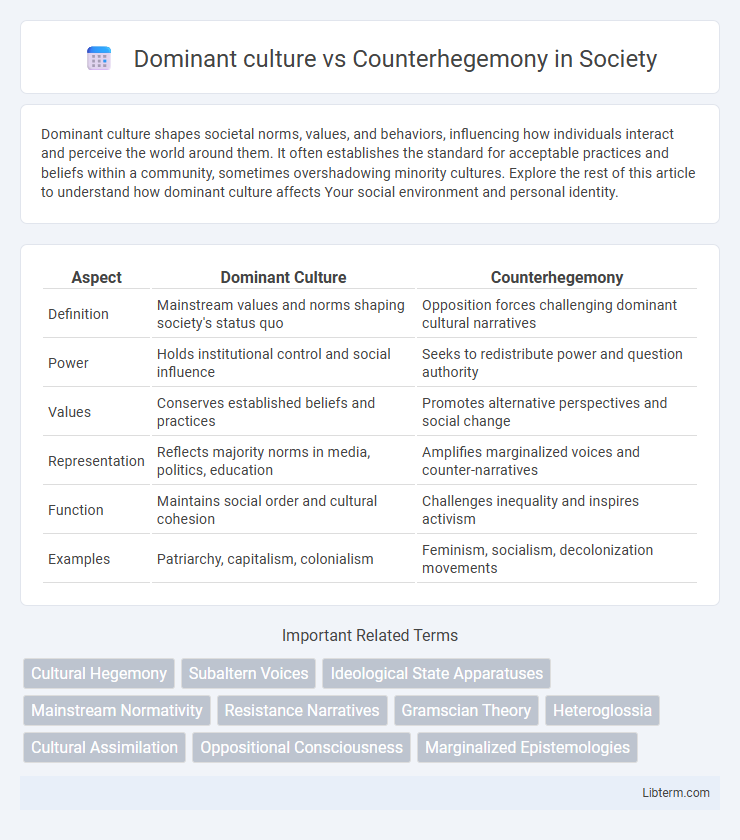Dominant culture shapes societal norms, values, and behaviors, influencing how individuals interact and perceive the world around them. It often establishes the standard for acceptable practices and beliefs within a community, sometimes overshadowing minority cultures. Explore the rest of this article to understand how dominant culture affects Your social environment and personal identity.
Table of Comparison
| Aspect | Dominant Culture | Counterhegemony |
|---|---|---|
| Definition | Mainstream values and norms shaping society's status quo | Opposition forces challenging dominant cultural narratives |
| Power | Holds institutional control and social influence | Seeks to redistribute power and question authority |
| Values | Conserves established beliefs and practices | Promotes alternative perspectives and social change |
| Representation | Reflects majority norms in media, politics, education | Amplifies marginalized voices and counter-narratives |
| Function | Maintains social order and cultural cohesion | Challenges inequality and inspires activism |
| Examples | Patriarchy, capitalism, colonialism | Feminism, socialism, decolonization movements |
Defining Dominant Culture: Core Concepts
Dominant culture refers to the set of values, beliefs, norms, and practices that are widely accepted and promoted by the most powerful groups in society, shaping social institutions and everyday life. It exerts influence through ideology, media, education, and political systems to maintain social order and reinforce existing power structures. Understanding dominant culture involves analyzing how cultural dominance sustains social hierarchies and marginalizes alternative perspectives.
Understanding Counterhegemony: An Overview
Counterhegemony challenges dominant culture by questioning its values, beliefs, and power structures through alternative narratives and practices that resist mainstream ideologies. It mobilizes marginalized groups to create spaces of cultural and political dissent, aiming to shift societal norms and promote social justice. Understanding counterhegemony involves analyzing how subordinate groups negotiate and contest hegemonic power to transform dominant cultural paradigms.
Historical Evolution of Dominant Culture
The historical evolution of dominant culture reveals a dynamic process where ruling classes establish and maintain societal norms and values through institutions like education, media, and religion, reinforcing power structures over time. This cultural dominance shapes collective identity and legitimizes authority, often marginalizing alternative voices and perspectives. Counterhegemony emerges as a challenge to this dominance, seeking to disrupt and transform the prevailing cultural narratives imposed by dominant groups.
Mechanisms of Cultural Hegemony
Dominant culture maintains power through mechanisms of cultural hegemony such as media control, education systems, and institutional norms that shape societal beliefs and values to reflect ruling class interests. Counterhegemony emerges by challenging these dominant narratives via grassroots movements, alternative media, and critical pedagogy to expose and resist ideological domination. These opposing forces continuously negotiate cultural meaning, influencing social structures and power dynamics within society.
Forms and Strategies of Counterhegemonic Movements
Counterhegemonic movements utilize diverse forms such as grassroots activism, alternative media, and cultural resistance to challenge dominant cultural norms and power structures. Strategies include mobilizing marginalized communities, promoting counter-narratives, and engaging in civil disobedience to disrupt hegemonic ideologies. These approaches foster social change by creating spaces for marginalized voices and reshaping societal values against prevailing hegemonic dominance.
Media’s Role in Reinforcing Dominant Narratives
Media reinforces dominant culture by consistently promoting mainstream ideologies, values, and beliefs through news, entertainment, and advertising, shaping public perception and maintaining social norms. Counterhegemony challenges these prevailing narratives by producing alternative media content that critiques power structures and offers marginalized perspectives. This dynamic creates a battleground where control over cultural meaning is contested, influencing societal change and resistance movements.
Art and Literature as Counterhegemonic Tools
Art and literature serve as powerful counterhegemonic tools by challenging the narratives imposed by the dominant culture, allowing marginalized voices to emerge and contest prevailing ideologies. Through subversive themes, styles, and storytelling, counterhegemonic works critique social injustices, promote alternative perspectives, and inspire collective resistance. This dynamic empowers cultural production to reshape identity and ideology beyond the control of dominant hegemonic structures.
Impact of Counterhegemony on Social Change
Counterhegemony challenges the dominant culture by promoting alternative values and social norms that resist mainstream power structures, fostering critical awareness and mobilizing marginalized groups. This resistance catalyzes social change by disrupting accepted ideologies, encouraging democratic participation, and enabling the reclamation of cultural identity. Through sustained counterhegemonic movements, societies experience shifts in power dynamics, leading to increased social justice and equity.
Case Studies: Dominant Culture vs Counterhegemony
Case studies of dominant culture versus counterhegemony reveal how prevailing social norms and values are continuously challenged by marginalized groups seeking to disrupt power structures. Examples include the civil rights movement in the United States, which contested systemic racism embedded in dominant cultural practices, and indigenous activism advocating for land rights against colonial legacies. These cases illustrate how counterhegemonic movements utilize cultural production, protest, and alternative narratives to resist and reshape dominant ideological frameworks.
Future Trends in Cultural Power Dynamics
Future trends in cultural power dynamics suggest the continued rise of counterhegemony movements challenging dominant culture through digital platforms and decentralized media. Increased globalization and social media enable diverse identities to contest traditional narratives, reshaping cultural influence beyond national borders. Emerging youth-led activism and alternative subcultures further drive the fragmentation of monolithic cultural dominance, fostering pluralism and hybrid cultural expressions.
Dominant culture Infographic

 libterm.com
libterm.com